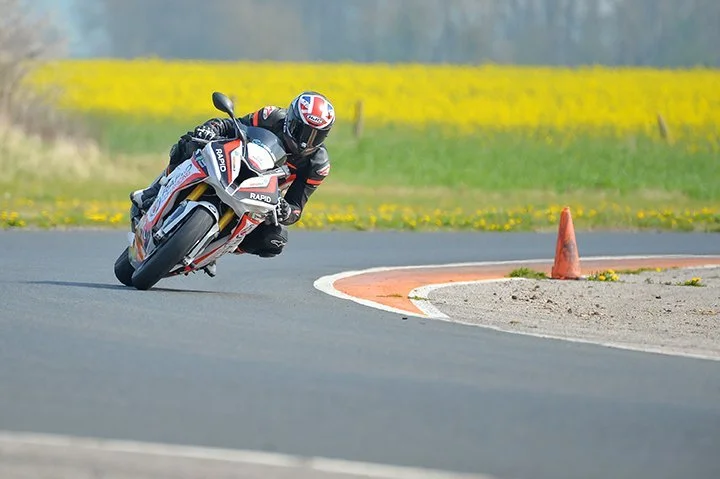MACHINE CONTROL - STABILITY AND TRACTION
We’ve spent a bit of time looking at planning, from how to gather information to the more specifics of cornering and overtaking. But now we get onto the hands on stuff: machine control, arguably the most crucial part of performance riding.
Learning how to optimise stability will let you use more of the bike’s potential, safely. The bike’s front wheel is designed to move freely and to follow the command direction given by you. It behaves just like a shopping trolley – making continuous adjustments to optimise its track.
On a bend, once your steering command - the initial steering input - is complete, the wheel naturally takes the exact track it needs to follow for optimum stability. And it does this effortlessly, precisely, and best of all, automatically.
However, the untrained rider can spoil this: if you grip the ‘bars too tightly you stop the front wheel finding its natural position and stability is reduced. And unfortunately, it’s often where stability is at its most valuable, such as fast corners, where riders are most likely to grip the ‘bars’.
As a result, one of the most important fundamental skills you need to master is how to keep a light grip on the bars, especially in challenging situations.
Weight transfer and rough handling
Considerable weight transfer happens during braking and acceleration and this affects stability by changing what grip is available from the tyres and how well the suspension keep tyres in contact with the road. Rough handling also reduces stability and can cause a loss of traction. To prevent this you should use the controls smoothly and progressively. Similarly, moving your body weight around on the bike must also be done smoothly.
Practice relaxing the arms and moving body position smoothly to enhance machine control.
A tight grip on the ‘bars impacts both weight transfer and handling. Stiff arms transfer weight onto the suspension and front wheel, potentially overloading it, and a tight grip limits your ability to operate the controls smoothly. You need to practice braking, accelerating, and steering with relaxed arms.
The traction basics
Many riders underestimate the effect they can have on traction. But it is directly affected by weight and coefficient of friction – both of which you can have significant impact on.
The coefficient of friction is a measure of the grip between two surfaces in contact. The ‘stickier’ they are, the higher the coefficient of friction and the more grip there is available. You can have a huge effect on this by your choice of tyres, the pressure you run them at, their condition and their temperature. You can also select which part of the road to ride on; wet and poorly-surfaced areas have a lower coefficient of friction, so positioning the bike to take advantage of better quality areas of the road can offer substantial advantages.
Increased weight increases the force between two surfaces which improves traction. Run your finger lightly over a surface and you’ll get little traction. Push down and increase the pressure and you’ll get a lot more. Braking shifts weight off the rear tyre, reducing its traction, and onto the front tyre, increasing its traction. Acceleration has the opposite effect. How we use our throttle and brakes allows us to move weight where we want it, when we want, and keeps the bike stable.
Suspension and traction
Suspension is designed to keep the tyres in contact with the road surface. Without it, the wheels would bounce off the asphalt. Suspension works best in the middle of its range and an expert rider will use machine control - throttle and braking inputs - to ensure it gets to its sweet spot as soon as possible when entering the bend.
Traction is a shared resource
Let’s assume you have a maximum of 100 units of traction, and that’s the maximum grip the tyre can provide.
These units must be shared between cornering, braking, and acceleration forces. If you are at maximum lean and using all 100 units of traction you have none left for braking or throttle, and any significant input will break traction. Likewise, if you are using them all on braking or throttle, there are none left for cornering.
This mean that throttle and brakes can be used when cornering but they must be used proportionately. If you enter a corner under heavy braking, the brakes need to be tapered off as you increase lean angle. And if you want to get back on the gas you need to time this roll on with standing the bike up.
The best place to learn to get to grips with traction and machine control is on a structured track day. Check out RAPID track training here.


